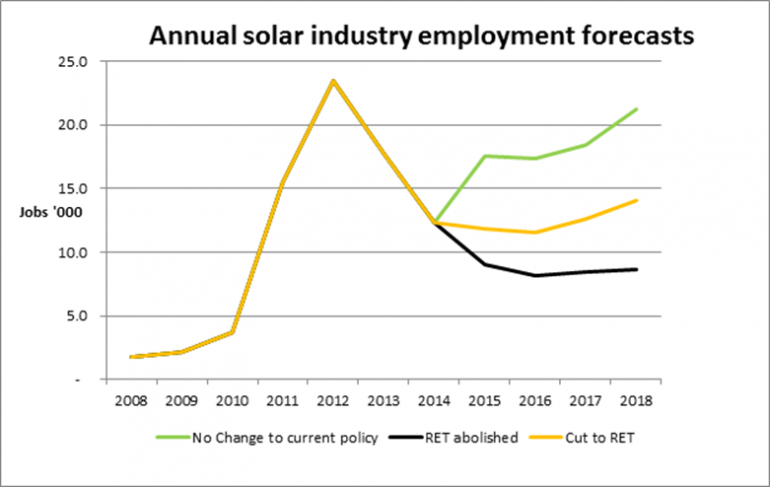Renewable energy is booming in the United States, with renewable technologies accounting for 37% of the new electricity generation capacity in the country in 2013. With this has come a huge uptick in the number of renewable energy jobs. Most notably, the number of solar-related jobs has skyrocketed in recent years outpacing the overall national job growth rate by a factor of 10, according to the US Solar Foundation’s National Solar Jobs Census 2013.
The US solar industry employed approximately 150,000 people in the year 2013, up about 20% from the previous year. 77% of the 24,000 positions added to the solar sector were bona fide new jobs; the remaining 33% were positions that were expanded to include additional responsibilities. The job category that saw the most expansion was installers, which grew 22% from 2013, matching up nicely with the news that the US was the 3rd largest solar market globally for the year–following China and Japan but ahead of the longstanding title-holder, Germany, who this year fell to 4th place. The Solar Foundation expects this trend to continue into 2014, with US solar jobs growing another 15% over the next 12 months–about 22,000 new solar workers.
Meanwhile, in Australia, a similar report about employment in Australia’s own solar industry has been released. The report (PDF), compiled by Solar Business Services in partnership with the REC Agents Association and GreenBank Environmental, takes a look at the potential consequences of the impact that the alteration, weakening or even elimination of Australia’s small-scale Renewable Energy Target (RET) could have on the sector. The report is timely in light of the fact that the RET is due for a review this year and many in the solar industry are concerned about how the scheme will fare at the hands of a government less friendly to renewables than the previous one.
The report examines 3 scenarios and makes some educated guesses as to how the number of solar jobs will expand or contract under each of them. These are: 1) a ‘business as usual’ scenario, in which the RET remains unaltered, 2) a scenario in which the RET is cut and 3) another in which the RET is completely abolished.
The chart below maps the potential outcomes of these 3 possible futures. Under scenario 1), the Australian solar industry would continue on its current growth trajectory, adding 8,000 jobs out to 2018. This stands in sharp contrast to the net loss of 2,000 jobs next year alone if the RET is eliminated altogether. Eventuation of the intermediate scenario, 2), would see a drop in job numbers next year to the tune of about 600, followed by a slow recovery. In 2013, Australia’s solar industry employed approximately 15,000 people in the production, sale and installation of systems. A loss of well over 6,000 jobs by 2018 under a “no RET” scenario, should one come about, would effectively mean a halving of the jobs in the sector.
Image via REC Agents Association / Solar Business Services
The Australian solar industry has seen its share of turmoil in recent years, with an incentive-driven boom ending with a series of hard thumps from which it is still slowly but steadily recovering. Interestingly, it the market for residential solar systems is arguably more ‘mature’ than the US solar market given that 1 in 10 households already has a system installed, and the industry has already gone through significant growing pains. In terms of larger-scale solar power, however, Australia still lags far behind many other nations.
© 2014 Solar Choice Pty Ltd
- Solar Power Wagga Wagga, NSW – Compare outputs, returns and installers - 13 March, 2025
- Monocrystalline vs Polycrystalline Solar Panels: Busting Myths - 11 November, 2024
- Solar Hot Water System: Everything You Need to Know - 27 February, 2024
